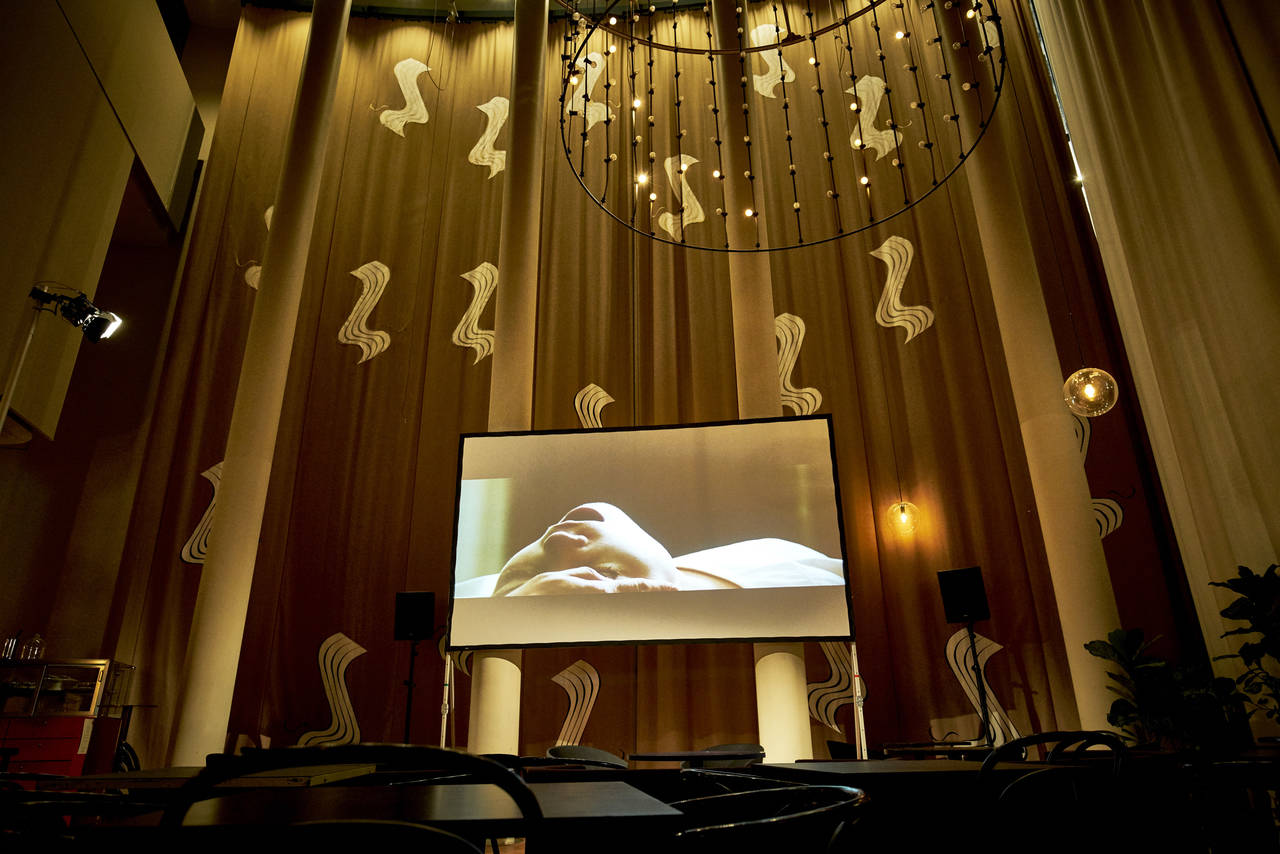It’s the blue hour – that moment after the sun has gone done and before darkness has descended. A man stands with his back to the camera; he holds onto a high parapet with one hand. He appears to be gazing into the distance, over the panorama of a city that spreads out before him.
From the left-hand edge of the picture, a black plume of smoke protrudes into the supposedly peaceful-seeming part of the picture, like an incision cut to divide the blue twilight sky from the city with somber black. Unexpectedly, the man suddenly turns around and sees the camera filming him, which for its part immediately turns in surprise and is placed on the ground. Some moments later we see only the purported cameraman, once again from behind, running away in the other direction.
Are we looking at the effects of a military strike?
With his two-minute film “With Michael in Jerusalem” (2015), the artist Hamza Halloubi, who was born in Tangier, Morocco in 1982, does not give the observer many points of reference, but by that very fact nevertheless specifically arouses our interest. The title pinpoints the location as Israel, while the column of smoke visible in the film leads us to speculate: Has there been an attack? Are we looking at the effects of a military strike? Or is this a forest fire? The sudden discovery of the camera, via which we were observing the man just moments before, alienates and exposes the actually non-participating observer as a voyeur who, in what follows, is then abandoned by the cameraman after he leaves the setting.
The position of the observer is something Halloubi explores time and again: In “With Geo” (2016), he films US performance artist and musician Geo Wyeth. Without any kind of musical accompaniment, Wyeth faintly sings a song while dancing to and fro in his studio, all the while focusing his penetrating gaze on the camera. He draws closer and closer to it until his face eventually fills the entire image – clearly it’s a mobile phone camera filming in landscape 16:9 format. Suddenly the camera pans 180 degrees and we see Hamza Halloubi himself – the filmer becomes the filmed.
The filmer becomes the filmed
There is a similar situation in “Travelling” (2016): A young woman looks at a book of photographs. As in “With Michael in Jerusalem”, she suddenly looks up and stares directly into the camera, which then again rotates on its own axle and eventually shows the artist himself making a run for it. In his words, Hamza Halloubi thus not only transforms his own position, turning the off-screen author into the on-screen actor, but also references the discrepancy between his and the observer’s perspective: The observer becomes the third variable in an equation, with a standpoint which varies significantly from that of the artist.

Confrontation with the disparity of individual perspectives is something Hamza Halloubi explores in other pieces, too: In “Nature Morte” (2013), he extensively explores the still lifes painted by Italian Giorgio Morandi, encouraging consideration of the political content of such works. In “Passage” (2015), which – like “With Michael in Jerusalem” – emerged from an artist’s residency in Jerusalem, Halloubi approaches the world-famous Al-Aqsa Mosque. However, the camera shows merely the inside of his jacket pocket, thus denying the observer the intrinsically manipulative content of the image being filmed.
Insights into the hustle and bustle of the metropolis of Tehran, including its perilous road traffic
As his favorite film, Hamza Halloubi has chosen “Ayneh” (“The Mirror” in English) by Iranian director Jafar Panahi. In the film, which was released in 1997, we accompany first-grader Mina (Mina Mohammad Khani) on her way home from school: The young girl waits in vain for her mother, who picks her up from school every day. When she doesn’t appear, Mina eventually makes her way home – sometimes with the help of adults, sometimes alone. “Ayneh” plays out in real time and offers a fascinating, documentary-like insight into the hustle and bustle of the metropolis of Tehran, including its perilous road traffic.
Around halfway through the film something unexpected happens: All of a sudden Mina breaks through the so-called “fourth wall”, looking directly into the camera and proclaiming that she doesn’t want to be in the film anymore. The view then opens up to the full film crew, including the director Jafar Panahi, who tries to convince the young girl to film another scene.
All of a sudden she breaks through the so-called “fourth wall”
The action in the first half of the film is repeated again, but as a supposed documentary in which a now clearly more resolute Mina makes her own way home and is secretly filmed by the camera team along the way. In “Ayneh” Panahi skillfully carves out the documentary elements of a film drama and, vice-versa, the dramatic elements of a documentary, and in the same stroke the observer is confronted with their own preconceptions and expectations with regard to a supposedly arthouse production. Just like Hamza Halloubi in his own works, in “Ayneh” Jafar Panahi thus also uses the moment of surprise to actively incorporate the viewer and thus draw them out of their habitual consumer behavior.


